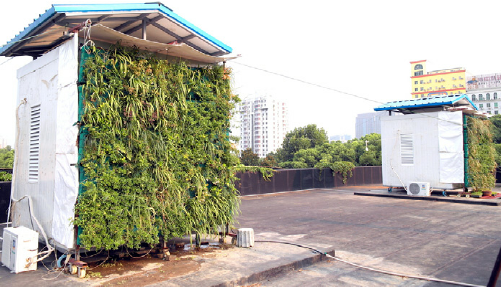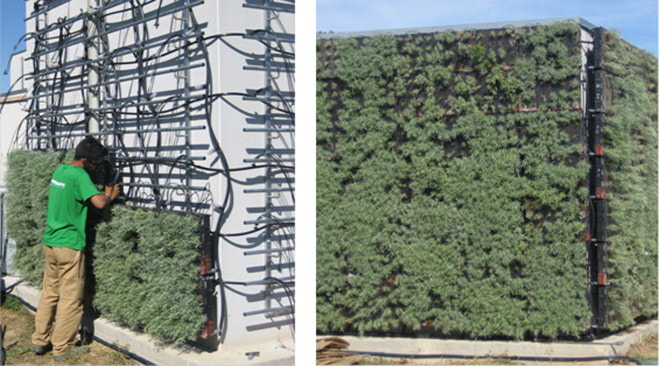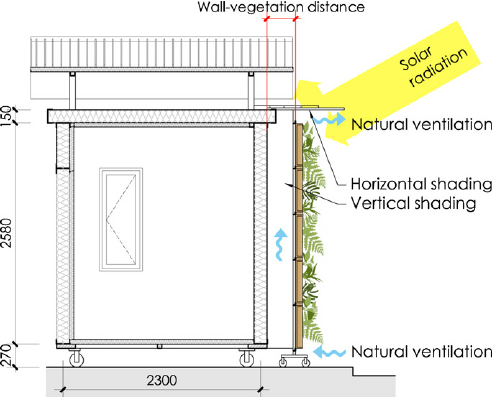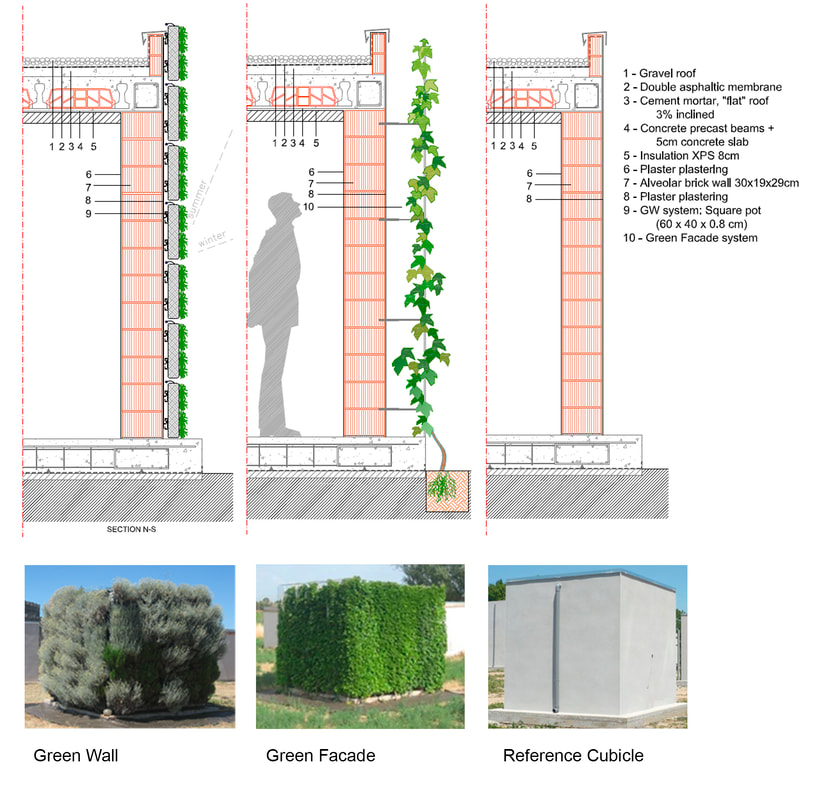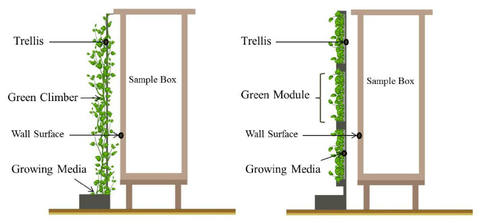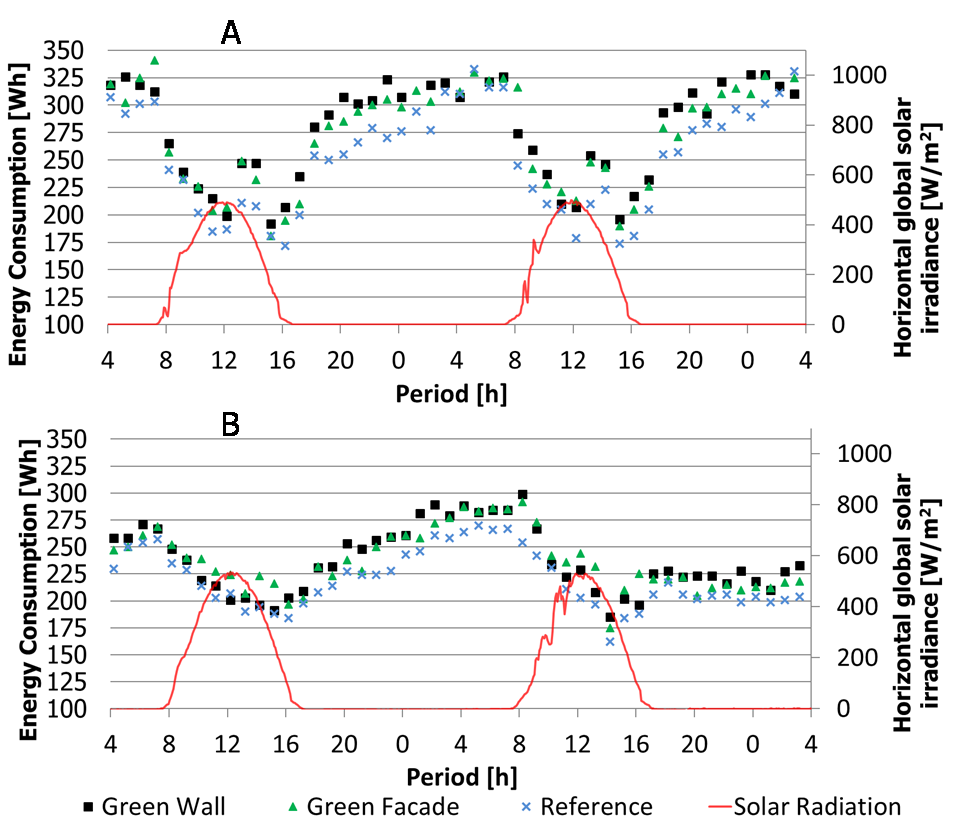Background
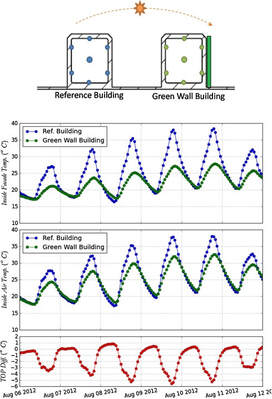
The field of study when it comes to green walls, living walls, vegetation walls, whatever you may call it has been studied for decades at this point. Trying to prove the point of whether this living wall is viable in modern architecture. Through most of human history, vegetation has been removed from the site to place a building down, but it’s becoming more appropriate to not only leave or replace that vegetation but add it onto the façades of the building. The growing climate crisis sparked the need for greater integration of plant life on the Earth. Plants have a natural ability to collect the rising CO2 levels, but subsequently, plants are also solid objects. They provide other features such as solar shading, thermal heat collection, and more. These sorts of features have been studied by dozens of people, countless academic articles published focuses on their research of these passive traits.
The article on, “Thermal Illuminance and Performance of a Translucent Green Wall,” focuses on the environmental and energy benefits that green facades can bring to buildings. This article is based on research that seeks to answer the question on whether green facades are helpful or just decoration. In order to see the benefits of a vegetated façade the researchers built two facades, one with and one without vegetation, and they were then applied to an experimental building. During the experiment a weather station was placed in the building and both facades were monitored to see how the facades reacted to different weather conditions. At the conclusion of the project it was shown that the use of a vegetated facade was better in handling changes in temperature, humidity, and solar radiation. Using the data collected the researchers also saw that the vegetated façade also brought about greater comfort to the interior of buildings in the summertime due to how it dealt with humidity and solar radiation. This research was done on the basis to raise awareness about the benefits of green facades and it also came to show that, “this prototype entails spatial innovation and is relatively easy to apply to housing construction.”
“Green walls: a sustainable approach to climate change, a case study of London,” is an article about research that seeks at evaluating the use of vegetated facades and the impact that they have on the environment and the climate change in London. The London project had two objectives, one was to look at the potential cooling affect that vegetated facades have on the environment and how they affect microclimate. The second objective of the research was to look at h the benefits of a vegetated wall and the thermal comfort that it brought to the occupants of buildings. Unlike the research conducted in the first article, this research looks to show the benefits of vegetated facades at a larger scale and it seeks to look at how these facades affect microclimate. This research is helpful because our research will be looking at how vegetated facades affect the comfort of the interior of buildings and the space surround buildings and this article seeks to answer just that. While the study is based on conditions in London, we will take the data, apply it to our won and begin to generalize it in order to gain a broader understanding of how vegetated facades work regardless of where they are located.
Budimir Sudimac’s research on thermal control and the establishment of vegetation walls in Belgrade gives an insight into how these green façades can have an effect on thermal conditioning. Sudimac’s goals are to show the energy potential of vegetation walls, based on Belgrade’s climate condition. Using simulation features from Revit Energy Analysis, Sudimac attempts to compare if the software was as valid as obtaining physical measurements using his own wall and testing procedures. Taking into account Belgrade’s position in the world and setting up an organized datasheet, the experimental wall was constructed to be mobile, allowing movement to compensate for the sun’s position every two weeks. Half the wall was covered in vegetation, while the other half was exposed. The results that Sudimac found was a 1.7°C difference between the vegetation wall and the base wall, an 8.33% difference. Taking these results into account, Sudimac later explains how to effectively apply this to residential buildings in Belgrade. A similar style test could be done for Charlotte’s climate situation. Sudimac ultimately concluded that the vegetation does a lot to block thermal heat transfer through the façade of the wall: “Solar radiation descending on the leaf area of the vegetation walls is partly reflected, part is used for photosynthesis, part is used in the process of evapotranspiration and a smaller part reaches the load-bearing part of the façade covering.”
Jiayu Li’s research article focuses on an attempt to “mitigate the urban heat island and release the low carbon potential of green walls.” Using Yuhou street in China as a layout: Li constructs four different scenarios of green walls, one with nothing on it, another with simply a green facade, another which is based the vegetation being planted in boxes, and another based on “super soil.” The main focus is the cooling performance that each scenario provides. Different tests were conducted on the scenarios on how the air temperature changed throughout the day, how it retained heat, how much heat it let out, and also how much outdoor temperature is being affected by these scenarios. Through most of the data collected, it all seemed very cumulative in their performance, with scenario 1 (simply the wall) doing the worse, and scenario 4 (super soil) doing the best. Upon collecting all this data, Li then moved to the economic standpoint of these green walls: their energy-saving capabilities. The final conclusion that Li came to was that the indoor temperature was all significantly affected by the three types of green walls in the scenarios. Subsequently, scenarios three and four provided huge results when it came to energy saving, equaling 6000-8000 W of refrigeration power. Despite all of this Li did note some shortcomings when it came to this research, one being the fact that all this data was collected during the summer, and can’t be said about winter months. Another being the vast difference it climate in other places than Yuhou Street.
The article on, “Thermal Illuminance and Performance of a Translucent Green Wall,” focuses on the environmental and energy benefits that green facades can bring to buildings. This article is based on research that seeks to answer the question on whether green facades are helpful or just decoration. In order to see the benefits of a vegetated façade the researchers built two facades, one with and one without vegetation, and they were then applied to an experimental building. During the experiment a weather station was placed in the building and both facades were monitored to see how the facades reacted to different weather conditions. At the conclusion of the project it was shown that the use of a vegetated facade was better in handling changes in temperature, humidity, and solar radiation. Using the data collected the researchers also saw that the vegetated façade also brought about greater comfort to the interior of buildings in the summertime due to how it dealt with humidity and solar radiation. This research was done on the basis to raise awareness about the benefits of green facades and it also came to show that, “this prototype entails spatial innovation and is relatively easy to apply to housing construction.”
“Green walls: a sustainable approach to climate change, a case study of London,” is an article about research that seeks at evaluating the use of vegetated facades and the impact that they have on the environment and the climate change in London. The London project had two objectives, one was to look at the potential cooling affect that vegetated facades have on the environment and how they affect microclimate. The second objective of the research was to look at h the benefits of a vegetated wall and the thermal comfort that it brought to the occupants of buildings. Unlike the research conducted in the first article, this research looks to show the benefits of vegetated facades at a larger scale and it seeks to look at how these facades affect microclimate. This research is helpful because our research will be looking at how vegetated facades affect the comfort of the interior of buildings and the space surround buildings and this article seeks to answer just that. While the study is based on conditions in London, we will take the data, apply it to our won and begin to generalize it in order to gain a broader understanding of how vegetated facades work regardless of where they are located.
Budimir Sudimac’s research on thermal control and the establishment of vegetation walls in Belgrade gives an insight into how these green façades can have an effect on thermal conditioning. Sudimac’s goals are to show the energy potential of vegetation walls, based on Belgrade’s climate condition. Using simulation features from Revit Energy Analysis, Sudimac attempts to compare if the software was as valid as obtaining physical measurements using his own wall and testing procedures. Taking into account Belgrade’s position in the world and setting up an organized datasheet, the experimental wall was constructed to be mobile, allowing movement to compensate for the sun’s position every two weeks. Half the wall was covered in vegetation, while the other half was exposed. The results that Sudimac found was a 1.7°C difference between the vegetation wall and the base wall, an 8.33% difference. Taking these results into account, Sudimac later explains how to effectively apply this to residential buildings in Belgrade. A similar style test could be done for Charlotte’s climate situation. Sudimac ultimately concluded that the vegetation does a lot to block thermal heat transfer through the façade of the wall: “Solar radiation descending on the leaf area of the vegetation walls is partly reflected, part is used for photosynthesis, part is used in the process of evapotranspiration and a smaller part reaches the load-bearing part of the façade covering.”
Jiayu Li’s research article focuses on an attempt to “mitigate the urban heat island and release the low carbon potential of green walls.” Using Yuhou street in China as a layout: Li constructs four different scenarios of green walls, one with nothing on it, another with simply a green facade, another which is based the vegetation being planted in boxes, and another based on “super soil.” The main focus is the cooling performance that each scenario provides. Different tests were conducted on the scenarios on how the air temperature changed throughout the day, how it retained heat, how much heat it let out, and also how much outdoor temperature is being affected by these scenarios. Through most of the data collected, it all seemed very cumulative in their performance, with scenario 1 (simply the wall) doing the worse, and scenario 4 (super soil) doing the best. Upon collecting all this data, Li then moved to the economic standpoint of these green walls: their energy-saving capabilities. The final conclusion that Li came to was that the indoor temperature was all significantly affected by the three types of green walls in the scenarios. Subsequently, scenarios three and four provided huge results when it came to energy saving, equaling 6000-8000 W of refrigeration power. Despite all of this Li did note some shortcomings when it came to this research, one being the fact that all this data was collected during the summer, and can’t be said about winter months. Another being the vast difference it climate in other places than Yuhou Street.
Sources
Li, Jiayu, et al. “Cooling and Energy-Saving Performance of Different Green Wall Design: A Simulation Study of a Block.” Energies, vol. 12, no. 15, 2019, p. 2912., doi:10.3390/en12152912.
Ojembarrena, Javier Alonso, et al. “Thermal and Illuminance Performance of a Translucent Green Wall.” Journal of Architectural Engineering, vol. 19, no. 4, 2013, pp. 256–264., doi:10.1061/(asce)ae.1943-5568.0000059.
Sudimac, Budimir, et al. “Thermal Extras of Vegetation Walls in Belgrade Climatic Conditions.” Thermal Science, vol. 22, no. Suppl. 3, 2018, pp. 945–955., doi:10.2298/tsci170919027s.
Solera Jimenez, Maricruz. “Green Walls: a Sustainable Approach to Climate Change, a Case Study of London.” Architectural Science Review., vol. 61, no. 1/2, 2018, pp. 48–57., doi:10.1080/00038628.2017.1405789.
Ojembarrena, Javier Alonso, et al. “Thermal and Illuminance Performance of a Translucent Green Wall.” Journal of Architectural Engineering, vol. 19, no. 4, 2013, pp. 256–264., doi:10.1061/(asce)ae.1943-5568.0000059.
Sudimac, Budimir, et al. “Thermal Extras of Vegetation Walls in Belgrade Climatic Conditions.” Thermal Science, vol. 22, no. Suppl. 3, 2018, pp. 945–955., doi:10.2298/tsci170919027s.
Solera Jimenez, Maricruz. “Green Walls: a Sustainable Approach to Climate Change, a Case Study of London.” Architectural Science Review., vol. 61, no. 1/2, 2018, pp. 48–57., doi:10.1080/00038628.2017.1405789.
Images
Djedjig, Rabah, et al. “Experimental Study of Green Walls Impacts on Buildings in Summer and Winter under an Oceanic Climate.” ScienceDirect, www.sciencedirect.com/science/article/abs/pii/S0378778817320200.
Safikhani, Tabassom, et al. “Thermal Impacts of Vertical Greenery Systems.” ResearchGate, www.researchgate.net/figure/Green-facade-Left-and-living-wall-Right_fig1_280918106.
Pérez, G., Coma, J., Martorell, I., & Cabeza, L. (2014, July 30). Vertical Greenery Systems (VGS) for energy saving in buildings: A review. Retrieved May 05, 2020, from https://www.sciencedirect.com/science/article/pii/S1364032114005073
Safikhani, Tabassom, et al. “Thermal Impacts of Vertical Greenery Systems.” ResearchGate, www.researchgate.net/figure/Green-facade-Left-and-living-wall-Right_fig1_280918106.
Pérez, G., Coma, J., Martorell, I., & Cabeza, L. (2014, July 30). Vertical Greenery Systems (VGS) for energy saving in buildings: A review. Retrieved May 05, 2020, from https://www.sciencedirect.com/science/article/pii/S1364032114005073
